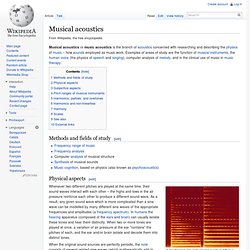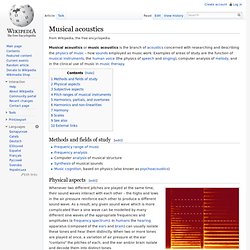

Musical acoustics. Musical acoustics or music acoustics is the branch of acoustics concerned with researching and describing the physics of music – how sounds employed as music work.

Examples of areas of study are the function of musical instruments, the human voice (the physics of speech and singing), computer analysis of melody, and in the clinical use of music in music therapy. Methods and fields of study[edit] Physical aspects[edit] A spectrogram of a violin playing a note and then a perfect fifth above it. The shared partials are highlighted by the white dashes. Subjective aspects[edit] Pitch ranges of musical instruments[edit] *This chart only displays down to C0, though the Octocontrabass clarinet extends down to the B♭ below that C. Harmonics, partials, and overtones[edit] Musical acoustics. Musical acoustics or music acoustics is the branch of acoustics concerned with researching and describing the physics of music – how sounds employed as music work.

Examples of areas of study are the function of musical instruments, the human voice (the physics of speech and singing), computer analysis of melody, and in the clinical use of music in music therapy. Methods and fields of study[edit] Physical aspects[edit] A spectrogram of a violin playing a note and then a perfect fifth above it. The shared partials are highlighted by the white dashes. Subjective aspects[edit] Pitch ranges of musical instruments[edit] *This chart only displays down to C0, though the Octocontrabass clarinet extends down to the B♭ below that C. Harmonics, partials, and overtones[edit] Overtones which are perfect integer multiples of the fundamental are called harmonics. The fundamental frequency is considered the first harmonic and the first partial. Scale of harmonics. Scale of harmonics on C.

Play Origin[edit] On the guqin, the left end of the dotted scale is a mirror image of the right end. The instrument is played with flageolet tones (harmonics) as well as pressing the strings on the wood. Harmonic series (music) Harmonic series of a string with terms written as reciprocals (2/1 written as 1/2).

A harmonic series is the sequence of all multiples of a base frequency. Any complex tone "can be described as a combination of many simple periodic waves (i.e., sine waves) or partials, each with its own frequency of vibration, amplitude, and phase. "[1] (Fourier analysis) A partial is any of the sine waves by which a complex tone is described. A harmonic (or a harmonic partial) is any of a set of partials that are whole number multiples of a common fundamental frequency.[2] This set includes the fundamental, which is a whole number multiple of itself (1 times itself). Typical pitched instruments are designed to have partials that are close to being harmonics, with very low inharmonicity; therefore, in music theory, and in instrument tuning, it is convenient to speak of the partials in those instruments' sounds as harmonics, even if they have some inharmonicity.
An overtone is any partial except the lowest. Resource.isvr.soton.ac.uk/spcg/tutorial/tutorial/Tutorial_files/transverspointcurated2.gif. ISVR - Institute of Sound and Vibration Research. Let us now imagine one of those particles that moves back and forth as the high and low pressure peaks of the wave pass. The greater the rate at which the point moves back and forth, the greater the frequency (f) of the wave (defined as the number of oscillation cycles a particle makes each second, and given the units of Hertz, Hz, which has dimensions of (1/time)). It is the inverse of the period (in seconds) which measures the amount of time it takes for a wave to complete one oscillation or cycle.
More generally, the distance between similar points on successive waves is called the wavelength λ (in metres). The speed at which the wave goes from one place to the other is called the wave velocity v (in metres per second). Frequency, wavelength and wave velocity are mathematically related by the equation: The velocity of a wave in a given medium (air, water, etc) is fixed and is related to the physical characteristics (temperature, density, etc...) of the medium.